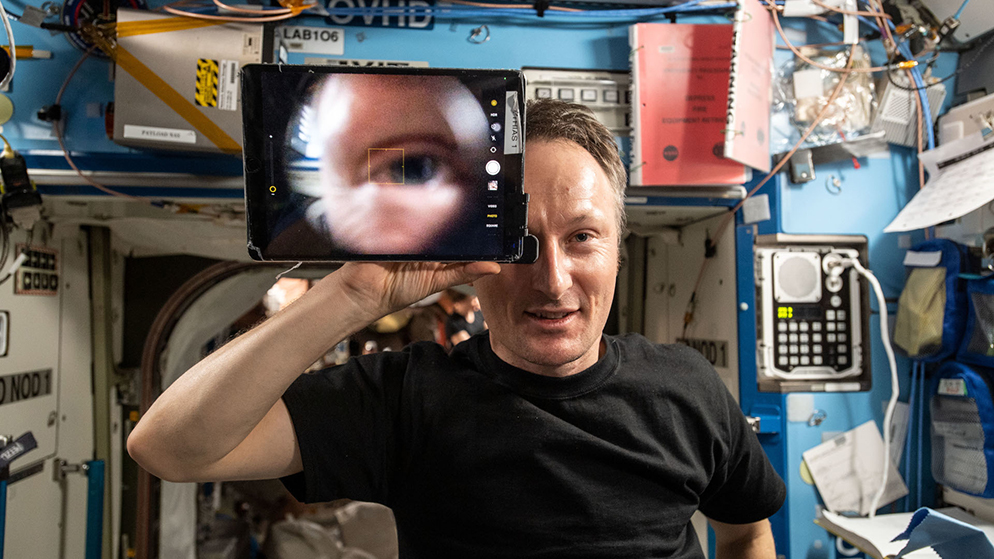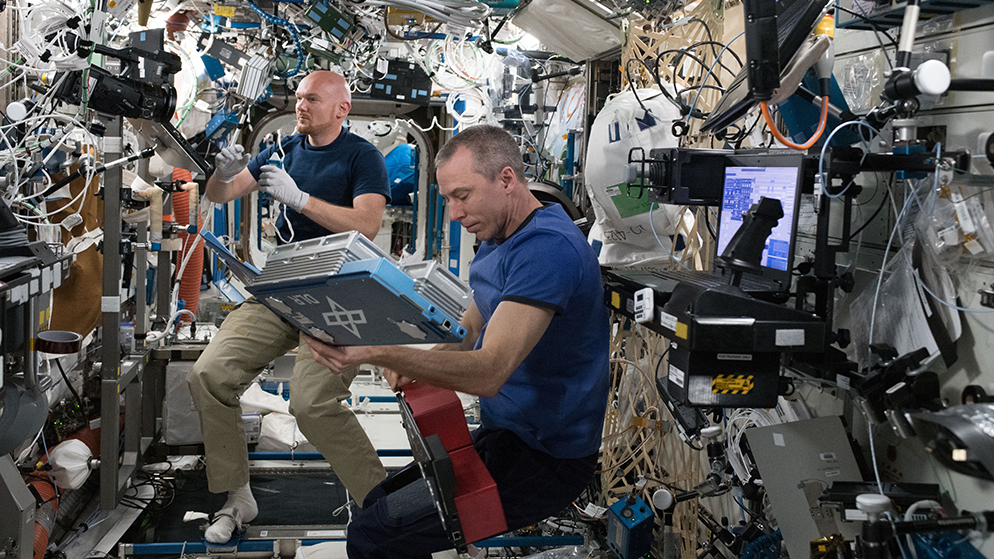Support making RiG more international!
Click here to start the surveySupport making "Research in Germany" more international! Your expertise and commitment are the key to the further development of promoting the German research landscape. We invite you to take part in our online survey and share your valuable experiences and opinions. Duration: 7-10 min.
Please start the survey at the end of your visit.
An apple from space a day – Medical innovations & space research
Medical research in space shows: Exploring space not only enhances our understanding of the cosmos, it can also help improve the health and well-being of people on Earth.

The human body is exposed to significant stress in the conditions of weightlessness and radiation. These stresses can lead to a variety of health problems, including muscle wasting, bone loss, vision problems and even cancer.
To address these issues, scientists and doctors have been working with the space industry to develop innovative technologies and treatments. These include questions such as: How can the spread of disease be controlled in extreme confinement? Why do human cells behave differently in weightlessness? And how can health problems be detected without a doctor around?
Win-win for space and Earth
The knowledge and technology gained in space or through space research to answer these questions can also be used to treat patients on Earth. For example, in the video below you can see how research into the spread of viruses during a space mission can help to contain the outbreak and spread of a virus here on Earth, as happened during the Corona pandemic.
Just one example of the many exciting research projects in Germany in which technologies and methods from space research are helping to better understand and treat diseases here on Earth.
Bruno helps to stop viruses spreading on space missions and planes
How can the outbreak of a virus be stopped as quickly as possible during a space mission? And how can this be applied to air travel to prevent further pandemics?

José fights cancer in microgravity
Cancer cells exhibit some interesting behaviour when exposed to microgravity. Find out how José is trying to understand this process to help cancer patients here on Earth.

FLUMIAS – Observing living cells in microgravity

Observing living cells in microgravity on the ISS? FLUMIAS made it possible.
German ESA astronaut Alexander Gerst took the FLUMIAS fluorescence microscope to the ISS in June 2018, where he and his colleagues recorded the first high-resolution images of living cells in space over an extended period of time. These images were then used to create 3D models and short films. Led by Prof. Daniela Grimm, researchers from the University of Magdeburg were thus able to make an important discovery: Our immune system adapts to microgravity after only a few seconds of disorientation.
But FLUMIAS is not only helping to ensure the health of astronauts on future long-duration space flights. People on Earth also benefit from basic research: For example, FLUMIAS is helping to deepen our understanding of neurodegenerative diseases, immune deficiencies and tumour development.
Optimised model already in the pipeline
A more advanced FLUMIAS model is already being prepared for use on the ISS. A special feature is that the microscope will be mounted on a rotor so that gravity can be switched on and off. It is also equipped with built-in life support systems and sample changers, and will be able to carry out six experiments in one mission. Scientists hope that this will provide important results for future long-term missions.
“Our goal is to find new targets to treat cancer”
Prof. Daniela-Gabriele Grimm is a globally leading scientist in the field of Microgravity and Translational Regenerative Medicine (MTRM) and Head of the Department of MTRM at the Otto-von-Guericke University Magdeburg (OVGU). In this interview, she talks about her research in real and simulated microgravity, parabolic flights and studying human cells on the ISS to find new approaches to cancer treatment.

More space research in Germany
Retinal Diagnostics
The mobile retina diagnostic system was an innovative highlight of the 'Cosmic Kiss' ISS mission conducted by the German ESA astronaut Matthias Maurer. The experiment was designed to make changes in the optic nerves and in the brain (Spaceflight Associated Neuro-ocular Syndrome; SANS) visible, thus helping to detect one of the most serious risks on space missions.
Learn more on the DLR websiteThe Myotones Experiment
The MYOTONES experiment the Charite Center of Anatomy for the first time investigated the effects of microgravity on resting muscle tone and related fascia and tendon structures that shape the human resting muscle tone (HRMT) system. German ESA astronaut Alexander successfully conducted the experiment on the ISS.
Learn more on the website of the Berlin Center of Space MedicineDr. Beat
Originally developed for space travel, this small device records the actual function of the heart and may in the future be worn on the body to monitor people's health status at home. The innovative idea won the title of best spin-off at the InnoSpace Masters conference in July 2023
Learn more on the website of the INNOspace Masters